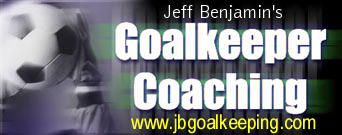
|
"Outstanding keeper instruction. This is a must for goalkeepers and coaches." —Ottawa Internationals S.C. web site, Ottawa, Canada |

|

|
Top |
Goalkeeping Tips, Tidbits and Random Thoughts
An athlete talking to themsleves during competition is hardly a new phenomenon.... The talk does not have to be vocal. By merely thinking you are talking to yourself and sending a message.
-- Tony DiCicco, Goalkeeper Soccer Training Manual
If you have a question, comment or rebuttal you'd like to see addressed here, send me email. I will post your mail to the blog at my discretion unless you specify otherwise.
Dealing with high winds
What a difference a few days makes! Last weekend, it was hot, around 30C, and sunny and everyone was complaining about the heat. Seven days later, it's around 10C, still sunny but that only helped a little against the driving NW wind (30-40kph). Our fields are oriented north/south, so I saw goalkeepers defending the south goal have to deal with strong, gusty winds.I typically will stay back a bit more on my line than I might usually do, and this is especially true for youth goalkeepers who aren't yet tall enough to deal well with high shots on a full-size frame, and females, who in general tend to not track flighted balls as well as males. Staying closer to the line will prevent long, carrying shots from ducking over the keeper and under the crossbar. In the end, remember the saying "Last to leave, first to the ball." Don't go forward on a lofted ball too soon and have it drift over your head -- wait a beat and judge it first; then once you've got a bead on it, go hard and win the ball.
But at the same time, the keeper must be ready to instantly come off the line and sweep up any long balls that get blown by everyone. It's difficult to balance this important task with protecting the line, and that's one of the reasons playing against the wind is so difficult. The goalkeeper must be alert and ready to sprint.
Distribution becomes troublesome too. Anything hit high in the air can come right back at you. This is where a drop kick can come in handy, as it tends to stay lower than a punt. You can also throw the ball to teammates checking back to the ball, and if all else fails, aim your punts for the sideline near the center stripe, so at worst they will go out for a throw.
Finally, make sure the team knows how to deal with the pressure of a strong headwind. First responsibility for preventing long shots falls to the midfielders, so don't let them collapse back with the defense -- make sure they stay up to prevent service. Then he defenders must be wary of trying to clear with big kicks up the middle since they'll come right back. The ball has to be worked out of the defensive end on the ground and wide, if possible.
Labels: Tactics
Improving your coaching skills
I just got an envelope in the mail with results from the USSF licensing course I took back in August, and I'm happy to report I can update my bio to say I received my National "C" license.I'm thrilled to have passed, but at the same time I'm a bit disappointed that I didn't get a bit better score. This is especially true since some of the items I needed to be better on (particularly talking less and getting the practice going again) were items I know I needed to work on, and were emphasized during the instruction. But that brings home the point that improving your coaching skills takes the same effort and time that it takes a player to improve their playing skills, and the process is very similar. It's one thing to intellectually know you need to work on something, and another thing altogether to turn it into a habit on the field.
We all see it with our players -- we pound a subject into their heads, whether it's stepping forward on a dive, or not tossing the ball up to punt it, or slapping the ball away instead of catching it, and sometimes we feel like we're pounding on a brick wall. But then, days or weeks or even months later, you notice all that pounding actually had an effect. Sometimes it's immediate -- you can all but see the light bulb go on, and the player instantly is better. Other times it's more subtle -- they start to have more "on" days than "off" days, and the lapses become fewer and farther between. We have to give ourselves the same latitude to improve as coaches. I need to work on making my coaching points more succinct, and I can guarantee you my players will be happier for it when it finally happens!
Just like playing skill, coaching skill takes knowledge, feedback, and the time and focus to put that knowledge into action. Gain knowledge however, you can, whether it's USSF, NSCAA, UEFA, FA or your own local or national federation educational programs, getting feedback from more experienced coaches, reading books or web sites. (And don't forget the closest source of feedback of all -- your own team and players!) Then push yourself to work hard and focus on your coaching skill just like you ask your players to do. Getting the piece of paper with the license on it is just the first step -- it's what you do with that paper that counts.
Labels: Miscellaneous
Size matters
As much as those of us who are vertically challenged wished otherwise, and those of us who coach U-littles lament, the fact of the matter is that size does matter when it comes to goalkeepers.Nowhere is this point proven more than in the women's game. I've seen numerous goals scored in the Women's World Cup and the late WUSA that would have been saved -- some easily -- had the goalkeeper been 6'2" (188cm) tall rather than just 5'8" (173cm) tall. In fact, that's the average height of starting goalkeepers in the United States' MLS men's league and the WUSA this year.
Brianna Scurry is one of the best female goalkeepers in the world at going back and parrying high balls over her head. But at just 5'8" (or 5'9", depending on which web site you believe), she has to be.
When you're dealing with youth, there's often not a lot you can do except wait for kids to grow. A full size frame is awfully big for even the tallest 10-year-old. And smaller goalkeepers can have advantages too, so don't go strictly for height on your youth team -- go with the best goalkeeper! But as you advance in age and level of play, the height factor will eventually become a factor.
Labels: Miscellaneous